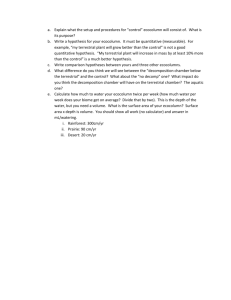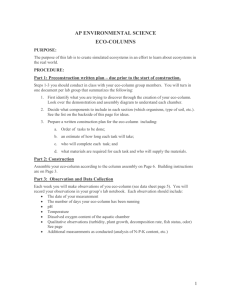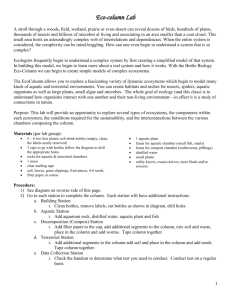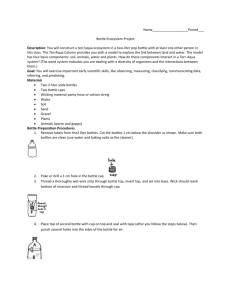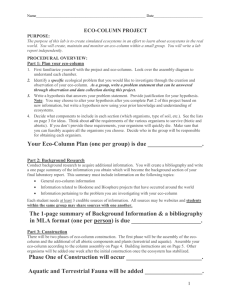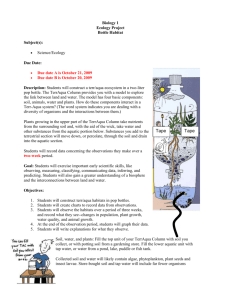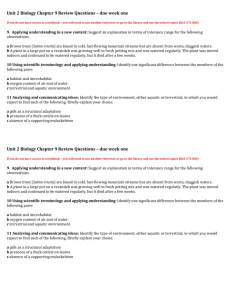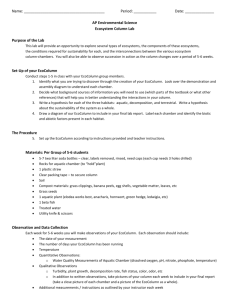Eco Columns
advertisement
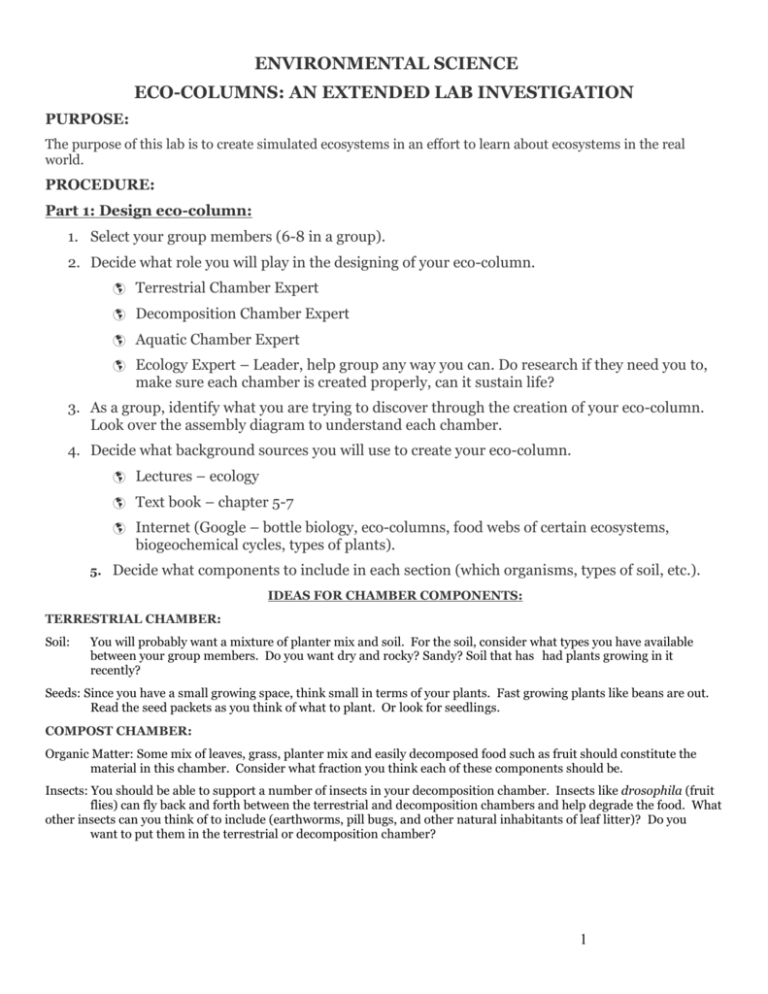
ENVIRONMENTAL SCIENCE ECO-COLUMNS: AN EXTENDED LAB INVESTIGATION PURPOSE: The purpose of this lab is to create simulated ecosystems in an effort to learn about ecosystems in the real world. PROCEDURE: Part 1: Design eco-column: 1. Select your group members (6-8 in a group). 2. Decide what role you will play in the designing of your eco-column. Terrestrial Chamber Expert Decomposition Chamber Expert Aquatic Chamber Expert Ecology Expert – Leader, help group any way you can. Do research if they need you to, make sure each chamber is created properly, can it sustain life? 3. As a group, identify what you are trying to discover through the creation of your eco-column. Look over the assembly diagram to understand each chamber. 4. Decide what background sources you will use to create your eco-column. 5. Lectures – ecology Text book – chapter 5-7 Internet (Google – bottle biology, eco-columns, food webs of certain ecosystems, biogeochemical cycles, types of plants). Decide what components to include in each section (which organisms, types of soil, etc.). IDEAS FOR CHAMBER COMPONENTS: TERRESTRIAL CHAMBER: Soil: You will probably want a mixture of planter mix and soil. For the soil, consider what types you have available between your group members. Do you want dry and rocky? Sandy? Soil that has had plants growing in it recently? Seeds: Since you have a small growing space, think small in terms of your plants. Fast growing plants like beans are out. Read the seed packets as you think of what to plant. Or look for seedlings. COMPOST CHAMBER: Organic Matter: Some mix of leaves, grass, planter mix and easily decomposed food such as fruit should constitute the material in this chamber. Consider what fraction you think each of these components should be. Insects: You should be able to support a number of insects in your decomposition chamber. Insects like drosophila (fruit flies) can fly back and forth between the terrestrial and decomposition chambers and help degrade the food. What other insects can you think of to include (earthworms, pill bugs, and other natural inhabitants of leaf litter)? Do you want to put them in the terrestrial or decomposition chamber? 1 AQUATIC CHAMBER: Water: Not all water is the same. Do you want to include fresh tap water? Old tap water? Distilled water? Pond water? What is your reasoning? Solid Material: Choose gravel or sand or a mix to go in the bottom of your aquatic chamber. Organisms: Fish, snails, and elodea can go in your aquatic chamber. Be especially careful to limit the number of larger organisms in the chamber as you will not open it to add food. Add only the number of consumers you think this chamber can support. Part 2: Set-up of eco-column 1. Write a hypothesis for each of three habitats: Aquatic, Decomposition, and Terrestrial (Each expert does this for your chamber). 2. Draw a diagram of each of your eco-column chambers and identify the biotic and abiotic factors present in each habitat. 3. Draw the potentially connected food webs you anticipate taking place within your eco-column. Make every effort to identify the species you have added as specifically as possible. If an organism is unidentifiable, include a drawing of it. Part 3: Construction 1. Bring in your materials: 5 clear 2-Liter bottles duck tape (any color) straws (2 or 3) soil for plants plants (make sure it’s a sturdy plant for indoor conditions) bugs for terrestrial chamber (spiders, crickets, pill bugs, fruit flies) dead leaves and fruit to decompose organisms (pill bugs, earth worms, fruit flies) fish tank rocks, sand or gravel (any color) live aquatic plants aquatic organism (beta fish, goldfish, danio, sucker fish, snails) 2. Assemble your eco-column according to the column assembly diagram and instructions that follow. Part 4: Observation and Data Collection Each week you will make observations of your eco-column. Record the data on the records table in your notebook. Each observation should include: The date of your measurement The number of days your eco-column has been running pH Temperature Dissolved oxygen content of the aquatic chamber Qualitative observations (turbidity, plant growth, decomposition rate, fish status, odor) Additional measurements as conducted (analysis of N-P-K content, etc.) Part 5: Group Lab Report 1. You will write one group report. Each of you does not have to turn one in. ONLY 1 PER GROUP!!!! 2. Part of the scientific method involves disseminating what you have learned. You will do this in the form of a lab write-up following the guidelines I give you. Make sure you keep good records in your lab book during the investigation so that you are not missing anything when it comes time to write. Good Luck!!! Take care of your mini-Earth in a bottle!! 2 3 BUILDING INSTRUCTIONS 1. Follow the instructions for making cuts in Column Assembly 2. Melt or drill a hole in three of the bottle caps and screw onto the cap for F, D, C. Note cap for D also has large hole in center. 3. Insert the straw through the hole in the bottle cap of what will be the Terrestrial habitat (bottle D). Straw should extend below cap and above soil. 4. Invert Bottle D (terrestrial habitat) over Bottle C and invert both over Bottle B (aquatic habitat). STOCKING INSTRUCTIONS Aquatic habitat (Bottle A) 5. 6. 7. 8. Add a layer of sand or topsoil (about 1 inch) to the deep base. Add a layer of gravel (about 1 inch) on top of the sand or topsoil. Add water to a level about 1 inch below the top of the cut. Plant aquatic plants with roots in the bottom sediment. A chopstick will help you push the stems or roots into the ground. 9. Arrange “boulders” and other objects on the bottom sediment. 10. Add floating aquatic plants (duckweed). 11. Let the aquarium sit until the sediment settles. 12. Add aquatic animals. Compost habitat (Bottle C) 13. Mix equal parts of sand and topsoil together and add leaf litter. 14. Mix food items in. 15. Add compost animals as needed (you may collect some with the leaf litter). Terrestrial habitat (Bottle D) 16. Add a layer (¾ inch) of gravel to the Bottle D 17. Mix soil and potting soil together, moisten, and add a layer (3-4 inches) over the gravel. 18. Add terrestrial animals that burrow to the soil (e.g., worms). 19. Plant terrestrial plants in the soil. 20. Arrange “dead trees” and other objects on soil. 21. Add the remaining terrestrial animals. Maintenance Instructions 22. Provide a light source, preferably indirect window light. A small desk lamp or plant light will work, too. For artificial lights, provide 12 – 14 hours of light daily. 23. Add a small amount of water to the terrestrial habitat weekly or when it appears to be drying out. A fine spray of water on the plants also maintains the unit well. 4
